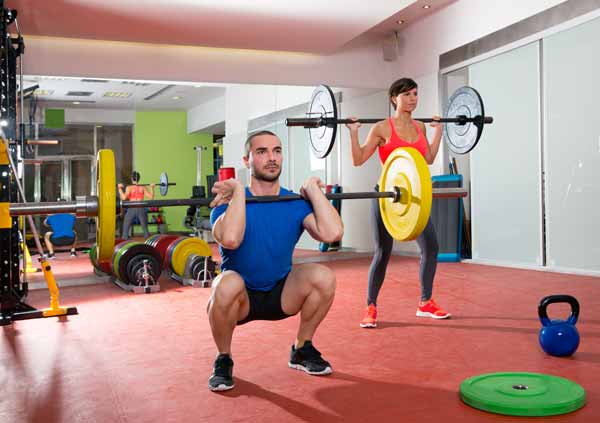
By Carl Valle
It’s impossible to ignore the impact of CrossFit when so many “boxes” are opening up in your area. Some polarizing views of CrossFit exists, with some are nearly cult like or some are very against the practices of the style of training. The influence of CrossFit with group exercise and existing business models is staggering, so when wealthy athletes or individuals enjoy the experience of a inexpensive option, disruption is occurring. Even proponents against CrossFit have changed their practices to meet the popularity and business model of group training, and while those naysayers will scoff at the training, their methods are simply more conservative CrossFit as individualized training is limited when providing group exercise. The real question is what will change CrossFit now that more and more coaches and fans are being exposed to specialists like Olympic lifters. Dmitry Klokov is seen all over CrossFit boxes and soon we will see more specialists, something that is not shocking but is surprising now. New technologies such as Wodify and more activity based wearable technologies. Outdoor or shared facilities like parks and public centers are offering a time share option for individuals to use a stripped down model of CrossFit that is growing in popularity. It seems that people want the CrossFit style but are moving to CrossFit like options.
The Future of CrossFit
I was interviewed in the CrossFit Journal: Recovery and Regeneration by Tyler Haas nearly a decade ago and didn’t know what CrossFit was. I liked the stripped down idea of essential equipment and bodyweight training, and felt that that model was going to grow. The group exercise model was very stigmatized by very female driven options like step aerobics and spinning classes, but while Jazzercise and other business have folded like Blockbuster, CrossFit has exploded. What we know is that CrossFit will evolve and those that don’t will find other CrossFit gyms growing. CrossFit found a combination of elements that people are fanatic about, and some small changes from education of program design will silence the critics and raise the standards. The next evolution of CrossFit is going to have movement towards technology and a change in applied training techniques. CrossFit will expand in more areas since what is essential is the training, not antiquated gyms and personal trainers. Those two new horizons will move CrossFit to the regular consumer, not just CrossFitter that is currently training at boxes. Ironically, the boot camp style of training will be forced to evolve from transparent data to increase safety of participants and measurable outcomes of the training. When a individual can link their exercise data to their own personal health with real data, who follows this direction and is prepared for services will be the leader.

The Daily WOD Evolved?
Change is rapid, and the Quantified Self is going more mainstream and this means eventually CrossFit will hit the digital revolution in some predicted and unexpected ways. Most CrossFit WODs, or workout of the day, include series of exercises and a repetition and time demand. CrossFit is about output, and the current question is what is going to be the output in the future? Doing more in less time or doing things longer or faster? What are the new metrics going to be with CrossFit besides doing Fran in X amount of time? What is fascinating is the competitions with CrossFit Games are creating a rapid evolution in coaching as money is involved. CrossFit is an agglomeration of different sports, the natural conclusion is going to be who trains the best will be the best, as the sport is competing in training. The elephant in the room with CrossFit is that what makes it popular is also what makes it limited. Doing a bunch of different things reduces specialization but improvement will hit a wall. The great news is track and field found out that the Decathlon faced the same challenges years ago when one is trying to do ten events well. Specialists were OK at the beginning but as the event improved, you had to be great at everything, not just good at some things. Since everyone has a finite amount of time and energy, better training decisions with better information is a consequence of the constraints of doing more in less time. Physiological monitoring like HRV, blood analysis, and power teasing is a common practice with elite sport, and Freelap is seeing growing interest from the CrossFit community wanting to time competitions and time workouts in different ways.
CrossFit and General Preparation Training with Freelap
With any training option, some general guidelines should be in place for athlete or client safety. Fortunately as things evolve, the consumer will raise his or her expectations of what is a sound training program and what is dangerous. Here are five areas that Freelap is being used in the training community and how CrossFit can learn from some of the best coaches in the world and apply those methods with advanced clients.
Timing Sprints
The most obvious use for Freelap is to see how fast is fast. When people sprint without time, the sensation of sprinting sometimes creates an unrealistic belief of their abilities, especially in the longer sprints. Various splits on the track or on the field, be it tempo runs or all out running can keep the speed prescription a little more precise, making each workout more successful.
Timing Rest Intervals
Just as important as the output, the rest interval must be timed to ensure that athletes are not cheating their rest period and leaving late or foolishly attacking something without sufficient rest. Rest intervals can be recorded in circuits easily by walking speeds and timing gates are not just for sprinting or running.
Timing Stations
Several areas in a circuit may be more demanding to different athletes or clients and it’s good to see a simple way of where success is present or where development is necessary. Provided the technique is spot on, the rep tempo can be assessed and audited for compliance and for change.
Timing Power
Similar to timing sprints, those using the prowler for general conditioning and fitness can gauge what weights allow for consistent speed instead of guesswork. Be it sled drags backwards or pushing heavy sleds, timing fitness work on the field is a good way to see if one is sustaining output.
Group training is an effective way to get many athletes or client fitter with limited equipment, but the training doesn’t need to be compromised. CrossFit has challenged the norms and pushed the envelope and the next step is making sure that the training continues to evolve. Simple measurement is not enough, but when timing is taken off the plate of coaches, technique can be a focus. Athletes doing circuits can see patterns and trends of improvement or decays in fitness when one is timing.
Please share this article so others may benefit.
[mashshare]

When was this blog written?